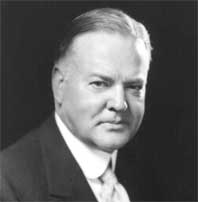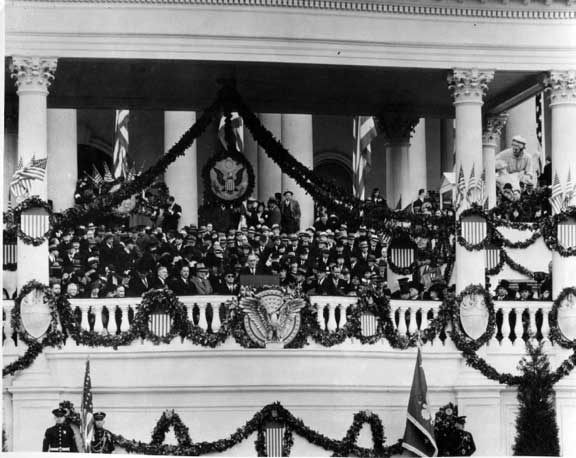 |
The Great Depression did not begin with a crisis in American banks. However, the financial crisis soon spread to banks. Bank after bank was forced to close, as one after another suffered a run on their bank. The worst year for the banks was 1931 when 2, 298 banks failed. In 1932, the situation had gotten better after Congress established the Reconstruction Finance Corporation to give emergency loans to banks. Still, as 1933 dawned, the state of US banks continued to worsen. Key banks were on the verge of failure. The banks in Detroit were saved only by a bank holiday. |
|
| Unfortunately, the period between the election and the time that the new President was sworn in was better suited for the days of the horse and not the modern world. Roosevelt's election had been in early November and Inauguration Day was not until March 4th. The country and the banks desperately wanted to hear assurances from Roosevelt what he was planning to do. The situation was getting more perilous by the day, and the world wanted to hear from the new President. |
 |
|
Roosevelt declined to make these commitments. Roosevelt refused because he believed there could only be one President at a time. Furthermore, FDR did not think the policies advocated by Hoover were correct. In the meantime, the contagion that hit the banks in Detroit did indeed spread to neighboring states. Millions of dollars were being pulled out of the banks each week.
The crisis appeared to deepen as inauguration day approached. In the end, 32 states closed at least some of their banks. In the waning hours of the Hoover Administration, his advisors, together with members of the incoming Roosevelt administration, tried to convince Hoover to declare a bank emergency and close all the banks. Hoover refused. He blamed the acute crisis on Roosevelt. Finally, in the wee hours of the morning before the inauguration, the incoming and outgoing Treasury Secretaries managed to convince the State Governors of each of the states with open banks to close them.
|
|
 |
As Inauguration Day dawned, the people of Washington, DC woke to a cold and cloudy day. Word slowly spread that all the banks in the country were closed. People would have to make good solely with the cash they had in hand. At noon, Roosevelt took the oath of office. Roosevelt promptly began what is considered one of the most famous inaugural addresses. In it, FDR stated the memorable line: "The only thing we have to fear, is fear itselfî. His speech stirred the audience and gave hope to a country that had begun to feel hopeless. |
|
Roosevelt was ready to implement a plan developed by his incoming Secretary of the Treasury, William Woodin, together with Hooverís outgoing Secretary of Treasury, Ogden Mills. Their three action points were: requesting a proclamation by the President, pursuant to the statue known as the ìTrading with the Enemies Actî to close all the banks; the second, calling a special session of Congress to enact legislation to strengthen the banking system; and the third, initiating a meeting with major bankers.
The closure of the banks, however, caused significant hardships. It was estimated that the average Bostonian had approximately $18 in hand when the banks closed. Without access to their money, the ability to cash checks, or even make change, businesses would quickly grind to a complete halt. People might starve. The government soon modified the closure of the banks to allow them to make change, cash government checks, and provide money for food and emergencies. In the meantime, work was proceeding at a rapid pace to present Congress with an Emergency Banking Bill. The bill was submitted to Congress on Thursday, March 9th, five days after the Rooseveltís inauguration. |
 |
|
The bill had four major provisions. First, the bill ratified the actions of the President in closing the banks. It also gave the President the authority to regulate the whole banking sector. Second, the bill gave the controller of the currency the power to appoint a receiver to take over any bank that was too weak to reopen. Third, the bill allowed banks to issue preferred shares and RFC to purchase. Finally, the law authorized the issuance of Federal Reserve Bank notes to provide additional liquidity to the banking system. The Emergency Banking Bill was introduced at 11 AM in the morning. At 8 PM, it was on the Presidentís desk for signature.
All of these measures would not be enough unless the public believed the banks that would reopen soon were sound. That job fell on the President. On Sunday, March 12th, President Roosevelt gave the first of what would become known as his"Fireside Chat" addresses.
The medium was the radio. At 10 PM, Roosevelt began his address. FDR started his speech by saying: "My friends, I want to talk for a few minutes to the people of the United States about banking. He went on to give a brief history of the crisis. Most importantly, FDR assured the American people that any bank that reopens would be sound; otherwise, the government would not allow it to reopen. Roosevelt urged the American people not to remove any more money from the banks, and even to return the money they had pulled out.
Franklin Delano Rooseveltís first "Fireside Chat"speech was probably the most successful speech in American history. The next day, when the first banks reopened, lines appeared, not to withdraw money, but to deposit it. The banking crisis was over. The swift actions of the Treasury Department, the Congress and, most importantly, the reassuring rhetoric of the President had ended this crisis. |
|
| |